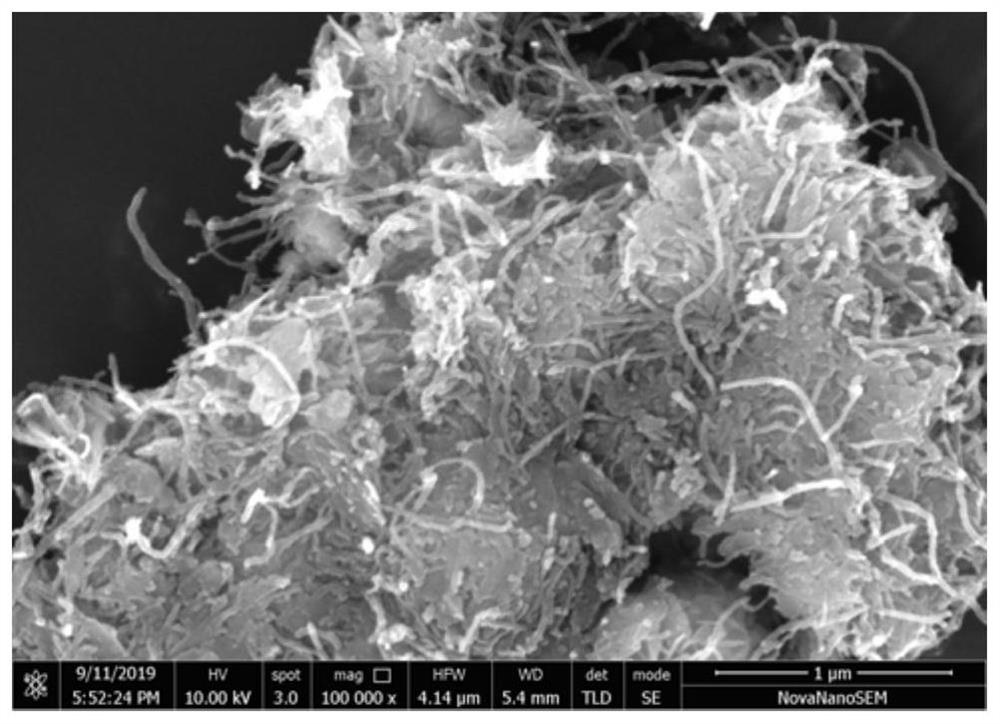Preparation method and application of beta-phase ferronickel hydroxide/carbon nanotube compound with atomic defects
A technology of hydroxide and carbon nanotubes, applied in metal/metal oxide/metal hydroxide catalysts, chemical instruments and methods, chemical/physical processes, etc., can solve problems such as low density and large specific surface area, and achieve The effects of reduced production costs, uniform size distribution, and simple experimental techniques
- Summary
- Abstract
- Description
- Claims
- Application Information
AI Technical Summary
Problems solved by technology
Method used
Image
Examples
Embodiment 1
[0022] Example 1, Preparation of β-phase nickel-iron hydroxide / carbon nanotube composites with atomic defects
[0023] Weigh 10 mg of carbon dioxide nanotubes in 40 ml of deionized water (N 2 ) in ultrasonic for 30min to disperse, then add 0.0357g (0.0375mol / L) nickel chloride hexahydrate, 0.0299g (0.0375 mol / L) ferrous chloride tetrahydrate, 0.2804g (0.05mol / L) hexamethylene Tetramine and 0.0222g (0.015mol / L) ammonium fluoride were dissolved and transferred to a polytetrafluoroethylene high-temperature autoclave. After reacting at 120°C / 6 h, wait for cooling and wash with deionized water to obtain a black powder . Subsequently, the powder was dispersed in a mixed solution of 50 ml of hydrogen peroxide and water (1:1 by volume) and mechanically stirred for 24 hours, then filtered and washed with deionized water and ethanol, and air-dried at room temperature.
Embodiment 2
[0024] Embodiment 2, preparation of β-phase nickel-iron hydroxide / carbon nanotube composite
[0025] Weigh 10 mg of carbon dioxide nanotubes in 40 ml of deionized water (N 2 ) in ultrasonic for 30min to disperse, then add 0.0357g (0.0375 mol / L) nickel chloride hexahydrate, 0.0299g (0.0375 mol / L) ferrous chloride tetrahydrate, 0.2804g (0.05mol / L) hexamethylene Tetramine and 0.0222g (0.015mol / L) ammonium fluoride were dissolved and transferred to a polytetrafluoroethylene high-temperature autoclave. After reacting at 120°C / 6 h, wait for cooling and wash with deionized water to obtain a black powder .
[0026] Synthesized atomically defective β-phase nickel-iron hydroxide / carbon nanotube composites such as Figure 1-2 As shown, indicating the successful growth of nanosheets on carbon nanotubes, the β-phase nickel iron hydroxide / carbon nanotube composites as image 3 shown.
[0027] The oxygen evolution performance of electrolyzed water is as follows: Figure 4 As shown, the ...
Embodiment 3
[0028] Example 3, Preparation of β-phase nickel-iron hydroxide / carbon nanotube composites with atomic defects
[0029] Weigh 5 mg of carbon dioxide nanotubes in 40 ml of deionized water (N 2) in ultrasonic for 30min to disperse, then add nickel chloride hexahydrate 0.05625mol / L, ferrous chloride tetrahydrate 0.01875mol / L, hexamethylenetetramine 0.03mol / L and ammonium fluoride 0.035mol / L after dissolving It was transferred to a polytetrafluoroethylene high-temperature autoclave, reacted at 120°C for 24 h, and was cooled and washed with deionized water to obtain a black powder. Then the powder was dispersed in a mixed solution of 50 mL of hydrogen peroxide and water (volume ratio 1:1) and mechanically stirred for 36 hours, then deionized water and ethanol were used to filter and wash the β-phase nickel iron with atomic defects air-dried at room temperature Hydroxide / Carbon Nanotube Composite.
PUM
| Property | Measurement | Unit |
|---|---|---|
| concentration | aaaaa | aaaaa |
Abstract
Description
Claims
Application Information
 Login to View More
Login to View More - R&D
- Intellectual Property
- Life Sciences
- Materials
- Tech Scout
- Unparalleled Data Quality
- Higher Quality Content
- 60% Fewer Hallucinations
Browse by: Latest US Patents, China's latest patents, Technical Efficacy Thesaurus, Application Domain, Technology Topic, Popular Technical Reports.
© 2025 PatSnap. All rights reserved.Legal|Privacy policy|Modern Slavery Act Transparency Statement|Sitemap|About US| Contact US: help@patsnap.com



